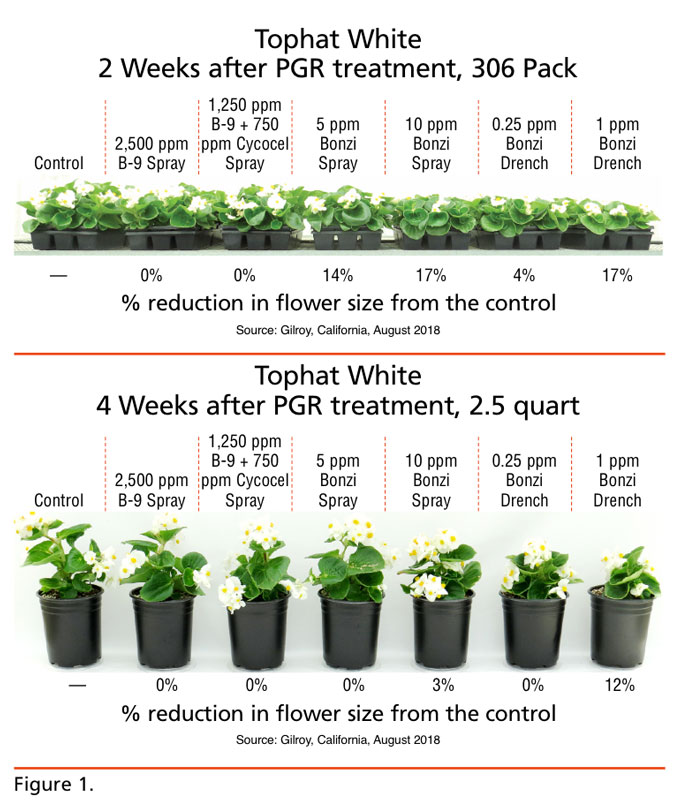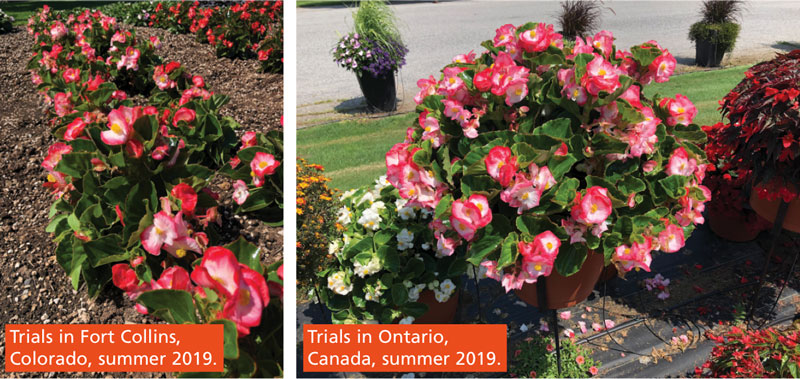11/1/2020
Tophat Interspecific Begonia
Dr. Alicain Carlson & Dr. Jamie Gibson

Tophat Begonia is an exciting addition to the XL begonia class from Syngenta Flowers. It has some notable benefits to growers and consumers that set it apart from the competition. Tophat had the first white flowered XL begonia on the market. It’s versatile and can be finished in many pot sizes, including 306 packs. It also totes the largest flowers and fastest finish compared to the competition.
Tophat’s naturally branching habit gives it a rounded, mounding habit that’s controlled and easy to ship. Flowers that cover the canopy at finish make it an outstanding gallon or 10-in. hanging basket crop. Tophat performs beautifully in the sun or shade and is great for in-ground or large containers growing to about 16- to 20-in. tall.
Tophat comes in Scarlet, White, Pink and Rose Bicolor. All the colors match well together to make excellent combinations. Rose Bicolor is the newest color addition and looks especially good in tri-color combinations with White and Pink.
Best practice propagation tips
Moisture management is key during begonia propagation and Tophat is no exception. Consistent moisture management and careful irrigation early in the plug crop results in highly uniform begonia seedlings, whereas uneven moisture leads to non-uniform growth and losses.
Apply enough irrigation at the time of sow to adequately soften the seed pellet. Keep a consistent moisture level 4 until germination to keep the pellet from re-hardening and restricting germination.
There are many benefits to pelleted seed, like making seed easier to see and sow, but be sure to apply enough moisture to dissolve the pellet from your begonia seed. Keep trays in the germination chamber at 72 to 78F (22 to 25C) for six to nine days to help ensure more uniform germination. If you don’t have a germination chamber, use tenting or fabric covering over the trays for the first two to three weeks.
After 21 days, true leaves should be expanding and covering can be removed. Use a low water volume and very fine mist nozzles when irrigating plugs for the first three weeks. Too much water pressure or large droplet sizes will move the tiny seeds around and delay seedling establishment. When first true leaves are about the size of a pencil eraser, water droplet size and water volume can be increased. Use fogger nozzles for spot watering. Very fine cone nozzles should be used for irrigation booms.
We recommend a 288-cell tray with one seed per cell for producing Tophat plugs. Light is beneficial for germination. Tophat begonia is daylength neutral and doesn’t have a photoperiod requirement. HID lighting providing higher daily light integral (DLI) will speed up germination and uniformity of seedlings. Plugs should finish in about six to seven weeks.
Fertilization can be increased over the course of the plug crop from 75 to 125 ppm nitrogen. Maintaining an electrical conductivity of 1.0 to 1.25 mS/cm (saturated media extract) and a pH range of 5.4 to 5.8 is critical to healthy plug growth. A B-Nine WSG spray a week before transplant may be needed to tone plugs.
Getting a quality finish
Tophat is very versatile and can be finished from 306 packs up to 3-gal. baskets. For 306 packs to 2.5 qt.-size containers, we recommend one plant per pot. For 3-qt. pots to 3-gal. baskets, we recommend three plants per pot to get to the fastest fill time. Finishing temperatures at an average daily temperature of 65 to 70F (18 to 21C) are recommended. Pinching isn’t necessary. Maintain moderate fertility at 150 to 200 ppm nitrogen for proper tone and growth performance.
Fungal pressures from low light and high humidity in the spring can be managed with proper air movement and broad spectrum fungicides labeled for begonias. Once plugs have established in the finish container, a plant growth regular (PGR) application of 2,500 to 5,000 ppm B-Nine WSG spray (daminozide) is recommended to control stem elongation without reducing flower size for 1-qt. or larger containers. Cool finish temperatures and high DLI maximize flower size and help to control excessive leaf expansion.
 Special considerations for 306 pack production
Special considerations for 306 pack production
Tophat performs exceptionally well in 306 packs. Choosing the right PGR will make it easy to have the best long-term quality for whichever retail outlet they get sold through.
We trialed several different PGR options to see what worked best without sacrificing flower size and final consumer performance, as shown in Figure 1. Tophat plugs were transplanted into 306 pack trays and treated with one of six PGR treatments (a control with no PGRs was also included) two weeks after transplant. Flower size measurements were taken two weeks later as the plants flowered and were marketable. Plants were then potted up into 2.5-qt. (trade gallon) pots to see how long it took to grow out of the PGRs and recover flower size. Measurements were taken every two weeks. Plants were evaluated until eight weeks post-PGR. Here’s what we found:
• 0.25 ppm Bonzi ornamental growth regulator drench is recommended, as plants will recover flower size by four weeks post-PGR and the consumer will still experience the extra-large blooms
• Bonzi spray treatments (5 to 10 ppm) significantly reduced flower size, but had good vegetative growth control; these treatments would provide lasting control for challenging retail environments
• Most plants grew out of the flower size reducing PGRs completely by four weeks post-PGR, except the 1 ppm Bonzi drench, which took eight weeks; although commercially saleable, this treatment negatively affects the consumer experience and isn’t recommended. GT
Dr. Alicain Carlson is the Technical Trial Manager and Dr. Jamie Gibson is a Technical Lead for Syngenta.